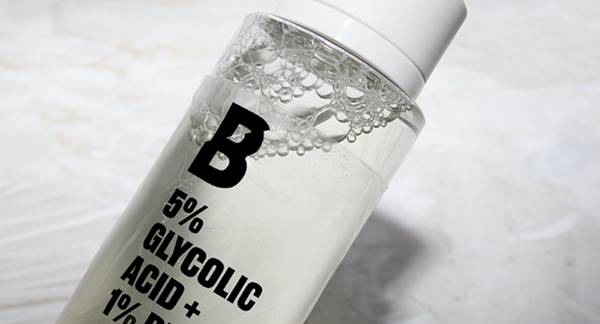Glycolic acid is a very popular alpha hydroxy acid (AHA) known for its skin-renewing and exfoliating properties. It is widely used in skincare products such as chemical peels, serums, and toners to promote smoother, more even-toned skin. Nonetheless, a prevalent worry among individuals incorporating glycolic acid into their skincare regimen is the possibility of experiencing a phenomenon known as “skin purging.” Let’s explore what skin purging is, why skin purging occurs, and whether glycolic acid can indeed lead to this temporary skin reaction.
Skin purging is a term used to describe a temporary worsening of the skin’s after introducing certain skincare products. It is frequently characterized by an increase in breakouts, including blackheads, whiteheads, and sometimes even inflamed acne. Purging typically happens when a product speeds up the skin’s natural exfoliation process, causing clogged pores and underlying impurities to come to the surface more quickly than they would under normal circumstances.
Skin purging is more likely to happen when a skincare product has cell turnover-accelerating or exfoliating properties. When a product like glycolic acid is applied to the skin, it helps to dissolve the bonds between dead skin cells on the surface, promoting the removal of damaged skin cells and unclogging pores. As a result, any tiny clogged hair follicles (pre-existing microcomedones) that were not yet visible on the skin’s surface might become more noticeable as they emerge.
Does Glycolic Acid Cause Purging?

Yes, glycolic acid can cause purging due to its acceleration of skin cell turnover, potentially leading to temporary breakouts before improvement. Glycolic acid is particular known for its ability to promote the shedding of dead skin cells and penetrate the skin deeply, making it an effective exfoliating agent. When people start using glycolic acid-containing products, the increased exfoliation can speed up the turnover of skin cells, which, in turn, can lead to the purging process.
When using glycolic acid, it’s important to note that not everyone will experience purging. While some people may not experience any adverse reaction, others may notice an initial increase in breakouts. The occurrence of purging mostly depends on an individual’s skin’s sensitivity, their skin type, and their pre-existing level of clogged pores.
How Long Does Glycolic Acid Purge Last?
The duration of a glycolic acid purge can vary from one individual to another and depends on several factors, including the concentration of glycolic acid being used, current skincare routine, your skin type, and your skin’s overall sensitivity.
During the purge phase, which generally lasts around 2 to 4 weeks, you might notice an initial worsening of your skin’s condition. This could manifest as increased breakouts, dryness, flakiness, and redness. These reactions happen because glycolic acid is a very potent exfoliant that works by dissolving the upper layer of dead skin cells, contributing cellular turnover and revealing fresher skin underneath.
Differentiating Purging from Irritation
While purging is a temporary process that usually lasts a couple of weeks as the skin adjusts, it’s essential to differentiate it from an adverse reaction. Irritation caused by glycolic acid can manifest as significant discomfort, excessive dryness, redness, or burning. If these symptoms happen, it’s advisable to discontinue use and see a dermatologist.
Managing Skin Purging
To manage the purging phase, it’s recommended to add glycolic acid gradually into your skincare routine. Start with a lower concentration and use it a few times a week before gradually increasing the concentration and frequency. Additionally, using a gentle moisturizer and cleanser and maintaining a consistent skincare routine can help support the skin’s healing process.
FAQs
Can glycolic acid purging be prevented or minimized?
Glycolic acid purging can be minimized by maintaining good skincare habits, using lower concentrations, gradually introducing the acid, and ensuring sun protection and proper moisturization. However, it may not be completely preventable, as it’s a natural part of the skin’s adjustment process to the exfoliating effects of glycolic acid.
How should one differentiate between an adverse reaction and purging from glycolic acid?
Distinguishing between purging from glycolic acid^and an adverse reaction involves evaluating factors such as breakout type, timing, location, duration, and severity.
- Purging usually happens in the first few weeks, leading to existing microcomedones to surface as minor breakouts, predominantly in usual breakout areas.
- Adverse reactions often include burning, itching, intense redness, or hives, affecting wider skin areas. If symptoms worsen or persist beyond the initial period, it’s likely an adverse reaction.
Are there specific skin types that are more prone to purging from glycolic acid?
Yes, skin types prone to purging from glycolic acid include oily, mature, acne-prone, textured, hyperpigmented, and congested skin due to their characteristics that make underlying impurities more likely to surface during exfoliation.
What products should be avoided while experiencing glycolic acid purging?
During glycolic acid purging, avoid using retinoids, harsh ingredients, and other strong exfoliants to prevent over-irritation.
Can glycolic acid purging occur on different parts of the face simultaneously?
Yes, glycolic acid purging can occur on different parts of the face simultaneously.
Can using glycolic acid too frequently lead to prolonged or more intense purging?
Yes, using glycolic acid too often can potentially lead to prolonged or more intense purging.
In conclusion, while glycolic acid can trigger skin purging thanks to its exfoliating properties, this reaction is generally temporary and indicates that the product is working to improve the skin’s clarity and texture. With patience and proper care, many individual find that their skin improves significantly once the purging phase subsides, revealing a more smoother and radiant complexion.


